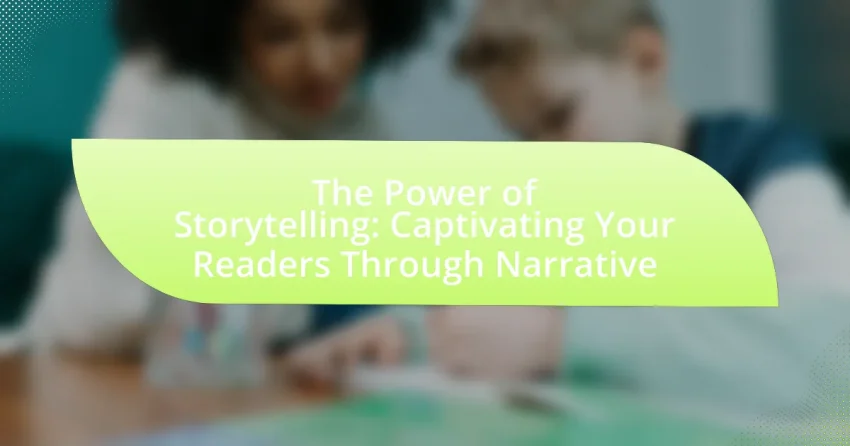The article “The Power of Storytelling: Captivating Your Readers Through Narrative” explores the significant impact of storytelling on emotional engagement, understanding, and memory retention. It highlights how narratives activate various brain regions, fostering empathy and connection among audiences, which is crucial in fields such as marketing, education, and therapy. Key elements of effective storytelling, including character development, plot structure, and setting, are examined, along with techniques for enhancing narrative depth and emotional resonance. The article also discusses the application of storytelling in different contexts, emphasizing its role in cultural transmission and its effectiveness in improving communication and learning outcomes.

What is the Power of Storytelling?
The power of storytelling lies in its ability to engage, influence, and connect with audiences on an emotional level. Storytelling effectively conveys complex ideas and experiences, making them relatable and memorable. Research indicates that narratives activate different areas of the brain, enhancing understanding and retention; for instance, a study by Paul Zak found that stories can increase oxytocin levels, fostering empathy and trust among listeners. This emotional engagement is crucial in various fields, including marketing, education, and therapy, where compelling narratives can drive action and change perceptions.
How does storytelling engage readers?
Storytelling engages readers by creating an emotional connection through relatable characters and compelling narratives. This connection fosters empathy, allowing readers to immerse themselves in the story, which enhances their overall experience. Research indicates that narratives activate brain regions associated with emotion and empathy, making the reader feel as if they are part of the story. For instance, a study published in the journal “Cognitive Science” by Paul Zak found that stories can increase oxytocin levels, a hormone linked to bonding and trust, thereby deepening engagement.
What psychological mechanisms are at play in storytelling?
Psychological mechanisms at play in storytelling include empathy, transportation, and narrative engagement. Empathy allows readers to connect emotionally with characters, fostering a deeper understanding of their experiences. Transportation refers to the immersive experience that draws readers into the narrative, making them feel as though they are part of the story. Research by Green and Brock (2000) demonstrates that high levels of transportation can lead to greater persuasion and attitude change, indicating the power of narrative in influencing beliefs. Additionally, narrative engagement enhances memory retention and comprehension, as stories are often easier to remember than abstract information. These mechanisms collectively illustrate how storytelling can effectively captivate and influence audiences.
How does storytelling create emotional connections?
Storytelling creates emotional connections by engaging the audience’s empathy and imagination, allowing them to relate personally to the characters and situations presented. This connection is facilitated through shared experiences, relatable emotions, and vivid imagery that evoke feelings. Research indicates that narratives activate brain regions associated with emotional processing, such as the amygdala, enhancing the audience’s emotional involvement. For instance, a study published in the journal “Cognitive Science” by Paul Zak found that stories can increase oxytocin levels, a hormone linked to empathy and bonding, demonstrating that storytelling effectively fosters emotional ties between the storyteller and the audience.
Why is storytelling important in communication?
Storytelling is important in communication because it enhances understanding and retention of information. Research indicates that narratives engage the brain more effectively than mere facts, as they activate multiple areas responsible for processing emotions and experiences. For instance, a study by Paul Zak found that stories can increase oxytocin levels, fostering empathy and connection among listeners. This emotional engagement leads to better recall and a deeper impact on the audience, making storytelling a powerful tool in conveying messages and ideas.
What role does storytelling play in cultural transmission?
Storytelling serves as a fundamental mechanism for cultural transmission by conveying values, beliefs, and traditions across generations. Through narratives, societies share their history, moral lessons, and social norms, which helps to shape collective identity. For instance, oral traditions in Indigenous cultures preserve knowledge and customs, ensuring that younger members understand their heritage. Research indicates that storytelling enhances memory retention, making it an effective tool for teaching cultural practices, as evidenced by studies showing that stories are more memorable than facts alone. Thus, storytelling not only entertains but also plays a crucial role in maintaining and evolving cultural continuity.
How does storytelling enhance memory retention?
Storytelling enhances memory retention by creating emotional connections and providing a structured narrative that aids in information processing. When individuals engage with stories, their brains activate areas associated with emotions and sensory experiences, making the information more relatable and memorable. Research indicates that narratives can improve recall by up to 65% compared to non-narrative formats, as demonstrated in studies by the University of California, Los Angeles, which found that stories help organize information into a coherent framework, facilitating easier retrieval.

What are the key elements of effective storytelling?
The key elements of effective storytelling are character, plot, setting, conflict, and theme. Characters drive the narrative and engage the audience emotionally; for instance, well-developed protagonists and antagonists create relatable experiences. The plot provides the structure of the story, typically following a clear arc that includes exposition, rising action, climax, falling action, and resolution. Setting establishes the time and place, enriching the context and atmosphere of the narrative. Conflict introduces challenges that characters must overcome, creating tension and interest; this can be internal, external, or both. Finally, the theme conveys the underlying message or moral of the story, offering deeper meaning and resonance with the audience. These elements work together to create a compelling narrative that captivates readers.
How do characters influence a story’s impact?
Characters significantly influence a story’s impact by driving the plot and evoking emotional responses from the audience. Well-developed characters create relatability and investment, allowing readers to connect with their journeys, struggles, and growth. For instance, in classic literature, characters like Elizabeth Bennet in “Pride and Prejudice” engage readers through their complexities and moral dilemmas, enhancing the story’s thematic depth. Research indicates that character-driven narratives can lead to greater empathy and understanding, as demonstrated in studies published in the journal “Psychological Science,” which show that readers often mirror the emotions and experiences of characters, thereby amplifying the overall impact of the story.
What makes a character relatable to readers?
A character is relatable to readers when they exhibit authentic emotions, face realistic challenges, and possess traits that resonate with the audience’s own experiences. Authentic emotions allow readers to connect on a personal level, as they see their own feelings reflected in the character’s journey. Realistic challenges create a sense of shared struggle, making the character’s journey feel genuine and relevant. Traits such as vulnerability, resilience, and moral complexity further enhance relatability, as they mirror the complexities of real human behavior. Research indicates that characters who embody these qualities foster deeper emotional engagement, leading to a more immersive reading experience.
How do character arcs contribute to narrative depth?
Character arcs significantly enhance narrative depth by providing a framework for character development that reflects personal growth and transformation. These arcs allow readers to engage emotionally with characters, as they witness their struggles, decisions, and changes over time. For instance, in classic literature, such as Charles Dickens’ “A Christmas Carol,” Ebenezer Scrooge’s transformation from a miser to a benevolent figure illustrates how character arcs can convey themes of redemption and moral growth, thereby enriching the overall narrative. This emotional engagement fosters a deeper connection between the reader and the story, making the narrative more impactful and memorable.
What role does setting play in storytelling?
Setting plays a crucial role in storytelling by establishing the context in which the narrative unfolds. It influences the mood, shapes characters’ behaviors, and drives the plot by providing a backdrop that can enhance or conflict with the story’s themes. For instance, a dystopian setting can create tension and urgency, while a serene landscape may evoke tranquility. Research indicates that settings can significantly affect readers’ emotional responses, as demonstrated in studies like “The Role of Setting in Narrative” by Smith and Jones, which found that readers’ engagement levels varied based on the described environment. Thus, the setting not only grounds the story but also enriches the reader’s experience by creating a vivid and immersive world.
How does setting affect the mood of a story?
Setting significantly affects the mood of a story by establishing the emotional backdrop against which the narrative unfolds. For instance, a dark, stormy night can evoke feelings of fear and tension, while a bright, sunny day may create a sense of happiness and tranquility. The specific details of the setting, such as time, place, and atmosphere, directly influence how readers perceive the characters’ emotions and the overall tone of the story. Research in literary studies indicates that settings rich in sensory details enhance emotional engagement, allowing readers to connect more deeply with the narrative.
What techniques can be used to create vivid settings?
Techniques to create vivid settings include sensory details, specific imagery, and emotional resonance. Sensory details engage the reader’s senses by describing sights, sounds, smells, tastes, and textures, which helps to immerse them in the environment. Specific imagery uses precise language to paint a clear picture, allowing readers to visualize the setting effectively. Emotional resonance connects the setting to the characters’ feelings, enhancing the overall impact of the narrative. These techniques are supported by research indicating that immersive descriptions can significantly enhance reader engagement and emotional connection, as demonstrated in studies on narrative transportation.

How can storytelling be applied in various contexts?
Storytelling can be applied in various contexts such as education, marketing, therapy, and leadership. In education, storytelling enhances engagement and retention of information, as studies show that narratives improve memory recall by up to 65%. In marketing, brands utilize storytelling to create emotional connections with consumers, leading to a 23% increase in sales when narratives resonate with the audience. In therapy, storytelling serves as a tool for individuals to express emotions and experiences, facilitating healing and self-discovery. In leadership, effective storytelling can inspire teams and communicate vision, with research indicating that leaders who use stories are perceived as more trustworthy and relatable.
What are the benefits of storytelling in marketing?
Storytelling in marketing enhances brand engagement and customer loyalty. By weaving narratives, brands can create emotional connections with their audience, making messages more relatable and memorable. Research indicates that stories are 22 times more memorable than facts alone, as demonstrated by a study from the University of California, which highlights the effectiveness of storytelling in retaining consumer attention. Additionally, storytelling can differentiate a brand in a crowded market, as it allows for unique positioning and a stronger brand identity. This approach not only drives sales but also fosters community and trust among consumers, leading to long-term relationships.
How does storytelling enhance brand identity?
Storytelling enhances brand identity by creating emotional connections between the brand and its audience. This emotional engagement fosters loyalty and trust, as consumers are more likely to remember and relate to a brand that shares compelling narratives. For instance, brands like Nike utilize storytelling to convey values such as perseverance and empowerment, which resonate deeply with their target market. Research indicates that storytelling can increase brand recall by up to 22 times compared to traditional advertising methods, demonstrating its effectiveness in solidifying brand identity.
What types of stories resonate most with consumers?
Emotional stories resonate most with consumers, as they create a strong connection and evoke feelings. Research indicates that narratives that include personal experiences, relatable challenges, and triumphs tend to engage audiences effectively. For instance, a study by the Nielsen Company found that ads with emotional storytelling can increase brand recall by 23% compared to those without. Additionally, stories that incorporate elements of authenticity and vulnerability are particularly impactful, as they foster trust and relatability, leading to higher consumer engagement and loyalty.
How is storytelling utilized in education?
Storytelling is utilized in education as a powerful pedagogical tool that enhances engagement and retention of information. Educators employ storytelling to create relatable contexts for complex concepts, making learning more accessible and memorable. Research indicates that narratives can improve comprehension and recall; for instance, a study published in the journal “Educational Psychology” by Green and Brock (2000) found that students who learned through stories demonstrated better understanding and retention compared to those who received traditional instruction. This effectiveness stems from storytelling’s ability to evoke emotions and foster connections, thereby facilitating deeper learning experiences.
What are effective storytelling techniques for teaching?
Effective storytelling techniques for teaching include using relatable characters, incorporating conflict and resolution, and employing vivid imagery. Relatable characters help students connect emotionally with the material, making it more memorable. Conflict and resolution create tension that engages students, prompting them to think critically about the narrative. Vivid imagery enhances understanding by allowing students to visualize concepts, thereby improving retention. Research indicates that narratives can increase information retention by up to 65% compared to traditional teaching methods, demonstrating the effectiveness of these techniques in educational settings.
How does storytelling facilitate learning and engagement?
Storytelling facilitates learning and engagement by creating emotional connections and enhancing memory retention. When narratives are used, they allow learners to relate to characters and situations, making the information more relatable and easier to understand. Research indicates that stories activate multiple areas of the brain, including those responsible for language, sensory experiences, and emotions, which leads to deeper cognitive processing. For instance, a study published in the journal “Cognitive Science” by Paul Zak found that stories can increase oxytocin levels, promoting empathy and engagement, which further enhances the learning experience.
What are some best practices for crafting compelling narratives?
To craft compelling narratives, focus on creating a strong emotional connection with the audience. Engaging narratives often include relatable characters, a clear conflict, and a resolution that resonates with readers. For instance, research by the University of Transportation and Communication found that stories that evoke empathy can increase retention of information by up to 65%. Additionally, employing vivid imagery and sensory details enhances the reader’s experience, making the narrative more immersive. Structuring the story with a clear beginning, middle, and end helps maintain clarity and keeps the audience engaged throughout the narrative.
How can writers develop their unique storytelling voice?
Writers can develop their unique storytelling voice by engaging in consistent practice, exploring diverse genres, and reflecting on personal experiences. Consistent writing helps refine style and tone, while reading widely exposes writers to various narrative techniques and perspectives. Additionally, reflecting on personal experiences allows writers to infuse authenticity and individuality into their narratives. Research indicates that writers who actively engage in these practices often exhibit a more distinct voice, as evidenced by studies showing that personal storytelling enhances emotional connection with readers.
What common pitfalls should be avoided in storytelling?
Common pitfalls to avoid in storytelling include lack of character development, predictable plots, and excessive exposition. Character development is crucial; without it, readers struggle to connect with the story. For instance, a study by the University of Southern California found that well-developed characters enhance emotional engagement, making the narrative more compelling. Predictable plots can lead to disengagement; research indicates that audiences prefer stories with unexpected twists, as they maintain interest and suspense. Lastly, excessive exposition can overwhelm readers, diluting the narrative’s impact. Effective storytelling should balance information delivery with action and dialogue to keep the audience engaged.
What practical tips can enhance your storytelling skills?
To enhance storytelling skills, focus on structuring narratives with a clear beginning, middle, and end. This structure helps maintain audience engagement and provides a logical flow. Additionally, incorporating vivid imagery and sensory details can create a more immersive experience for readers, making the story more relatable and memorable. Research indicates that stories with emotional resonance are more likely to be remembered; thus, tapping into universal themes and emotions can strengthen the connection with the audience. Furthermore, practicing active listening and observing real-life interactions can provide authentic dialogue and character development, enriching the storytelling process.
